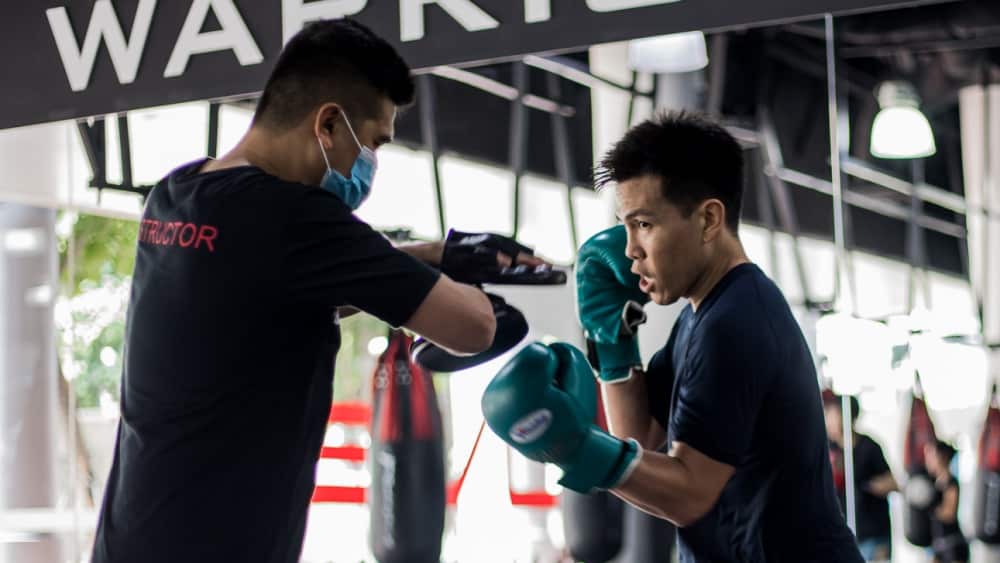5 Southpaw Techniques For Boxing

Guest post by Evolve MMA, Asia’s premier championship brand for martial arts. It has the most number of World Champions on the planet. Named as the #1 ranked martial arts organization in Asia by CNN, Yahoo! Sports, FOX Sports, Evolve MMA is the top rated Boxing gym in Singapore.
Southpaws are known for being elusive and slick in the boxing world. Many experienced orthodox boxers leave the ring frustrated and confused after their first bout against a southpaw. However, many boxers are also learning to adapt after a growing number of southpaws in recent years. Today, Evolve Daily shares 5 southpaw techniques that’ll help keep you ahead of the game.
1) Split Entry Counter
The split entry counter is an effective technique that counters an orthodox boxer’s best weapon – their jabs. As your opponent throws their left jab, take a step to your right with your right foot while simultaneously throwing a left straight, rotating your hips clockwise. Doing this takes your head off the centerline, slipping through your opponent’s jab, and aligning your left straight with their chin. Manny Pacquiao used this technique extensively throughout his legendary career, leaving devastating effects on his opponents.
2) Turning Your Opponent
This next technique is quite versatile and can be used in several ways. To turn your opponent, start by slipping through your opponent’s orthodox jab and stepping to your right simultaneously, leaving your opponent’s front foot positioned between both of your feet. This position is also where you’ll end up after a split entry counter, called the outside angle. Once you have the outside angle, wrap your right arm around your opponent’s waist placing your right hand on the right side of their hip, or as close as you can to it.
Next, turn your opponent’s hips counterclockwise as you pivot out and you’ll end up almost behind them. To finish off, throw a power shot with your left hand as they turn to face you. This creates a head-on collision between your opponent and your punch, potentially doubling its impact. Watch as Coach Tom Yankello demonstrates this drill with former IBF lightweight champion Paul Spadafora on turning opponents in the ring.
3) Michigan Crab And Philly Shell
The Michigan Crab is widely known as the Mayweather family’s signature style. The shoulder roll and side stance play crucial roles in this style of defense. This style is very different from the common high guard and requires a lot of practice. Using a mirror can help prevent mistakes from being ingrained into your muscle memory as you learn the Michigan Crab.
Take a sideways stance and turn your head to your right, facing your opponent and right foot in front. Place your right hand across your stomach with your right elbow passing slightly behind your right shoulder. Your left elbow should be tucked into your ribcage and your left hand should hover right under your chin. This is your basic crab stance.
Your right hand and arm guard the body, covering vital points such as the liver, solar plexus, and spleen. Your left hand can parry, catch, or shield to defend against an orthodox right cross or left jab. Your right shoulder can help deflect orthodox jabs by lifting it slightly and defend against a left hook by rolling and lifting your right elbow. The Michigan Crab defense is especially effective when you are moving away from your opponent, as it primarily sets up rear hand counters.
While the Michigan Crab shines when moving backward, the Philly Shell excels when creeping towards your opponent. Another key difference is that the Philly Shell tends to set up lead hook counters, opposed to the rear hand counters of the Michigan Crab. Although the Philly Shell and Michigan Crab are similar styles, both styles have their distinct advantages and nuances. The Philly Shell shares some similarities to the Michigan Crab, both utilize a lowered lead hand and shoulder roll but serve very different purposes. Watch as Ken Norton often called the godfather of the Philly Shell, demonstrates its effectiveness in the ring. Notice that Ken Norton’s shoulders are much squarer compared to his opponents than Floyd Mayweather’s.
Despite the differences, both guards are powerful tools for southpaw boxers to gain an advantage over their opponents. Another key difference is the lead foot. In the Philly Shell, your lead foot should point forward, as opposed to the side in the Michigan Crab style. The last primary difference is that the Philly Shell utilizes a lot of waist movement and bending, while the Michigan Crab style has a more upright torso position.
4) Circling To The Inside
While the outside angle is a commonly known dominant position, the inside angle can also be used to great effect. The main concern is your opponent’s power hand, just as you circle towards it, your opponent is also circling towards your power hand. Lure your opponent into following you as you circle and suddenly shift directions. As you take a right step, throw a left cross or overhand. Your opponent will walk into your punch much like the split entry counter. Once your opponent catches on, you can fake the change in direction to set up your right hook. The inside angle for southpaws is an advanced and rarely used tool and is one of the reasons Cuban boxers have dominated the Olympic games for Boxing.
5) Gazelle Jab
A gazelle punch is named for the way you load body weight and spring forward – like a gazelle. The footwork for the technique involves turning your hips clockwise to place the majority of the weight onto your front foot and explosively shuffling forward with your punch. Orthodox boxers often throw gazelle hooks or uppercuts, but Marvelous Marvin Hagler threw a gazelle jab out of a southpaw stance. Doing so let him cover massive distances in the ring and catch most of his opponents off guard. The techniques discussed are favorites among the southpaw all-time greats such as Pernell Whitaker, Manny Pacquiao, and Marvin Hagler. As a southpaw, it’s important to continue developing skills and techniques to stay ahead of your opponents.
Try these techniques in sparring and add what works to your boxing style, some might perhaps even take your boxing game to a whole new level. These techniques are just the tip of the iceberg when it comes to boxing. Remember it’s not about flashy knockouts or highlight-reel submissions, it’s a fight to live another day.






